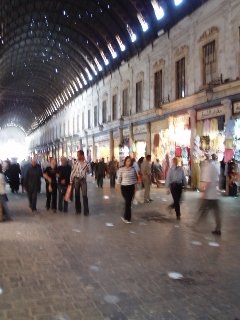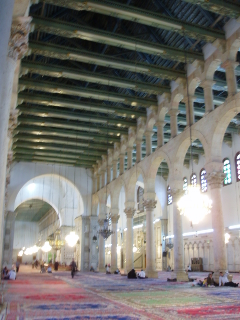The Old City of Damascus
The second day in Syria is devoted to touring the Old City of Damascus. First built by the Romans - Syria became a province of the Roman empire in 64 BC - and later transformed by Muslims, this part of Damascus still maintains the atmosphere of a medieval Islamic city (or so says the Lonely Planet). Let me show you several photos below.

A very narrow alleyway typical of the Old City of Damascus

Sharia al-Qaimariyya, a high street stretching straight to the east of Umayyad Mosque, is arcaded by vines, providing a pleasant daytime walk.

Souq al-Hamidiyya, an arcaded market street stretching to the west of Umayyad Mosque. The vault of corrugated-iron roofing, constructed in the late 19th century in honour of the visiting Ottoman sultan Hamid II, has lots of random bullet holes made by French planes during the nationalist rebellion of 1925, through which shafts of sunlight reach the cobbled pavement, an unintended decoration of the souq (as seen in the photo below).

Now it's time to visit Umayyad Mosque, built in 705 by the Umayyad Caliph al-Wahid ben Abdul Malek (at that time, Damascus was the capital city of the Umayyads, an Islamic Empire). Muslims are allowed to enter for free from any of the three gates while non-Muslims have to pay 50 SP (US$1) to be let in through the north gate. Women in Western gear need to put on a horrible khaki robe provided at the entrance, which deters Misao from getting into the Mosque till the present time. So I enter the Mosque alone. Oh, yes, you need to get off your shoes and take them with you as well.

The courtyard of Umayyad Mosque (click to enlarge). The marble floor and the walls surrounding the vast courtyard provides a tranquil atmosphere; many locals are dozing in the shade.
The Mosque has three minarets. On the north wall towers the Minaret of the Bride, the oldest among the three.

On the southeast corner, the Minaret of Jesus, the tallest.
And the most beautiful Al-Gharbiyya Minaret on the southwest.
 (viewed from ouside)
(viewed from ouside)
In the courtyard, two golden mosaics can be seen. One on the facade of the prayer hall (on the south of the courtyard).
 (Click to enlarge.)
(Click to enlarge.)
Let's get into the prayer hall. Here you can't put your shoes on the carpet; long wooden boxes are prepared. (Someone admonishes me...)

Maybe it looks somewhat out of place (as the Lonely Planet says), but a beautiful shrine sits on the floor of the prayer hall: the Shrine of John the Baptist.


A very narrow alleyway typical of the Old City of Damascus

Sharia al-Qaimariyya, a high street stretching straight to the east of Umayyad Mosque, is arcaded by vines, providing a pleasant daytime walk.

Souq al-Hamidiyya, an arcaded market street stretching to the west of Umayyad Mosque. The vault of corrugated-iron roofing, constructed in the late 19th century in honour of the visiting Ottoman sultan Hamid II, has lots of random bullet holes made by French planes during the nationalist rebellion of 1925, through which shafts of sunlight reach the cobbled pavement, an unintended decoration of the souq (as seen in the photo below).

Now it's time to visit Umayyad Mosque, built in 705 by the Umayyad Caliph al-Wahid ben Abdul Malek (at that time, Damascus was the capital city of the Umayyads, an Islamic Empire). Muslims are allowed to enter for free from any of the three gates while non-Muslims have to pay 50 SP (US$1) to be let in through the north gate. Women in Western gear need to put on a horrible khaki robe provided at the entrance, which deters Misao from getting into the Mosque till the present time. So I enter the Mosque alone. Oh, yes, you need to get off your shoes and take them with you as well.

The courtyard of Umayyad Mosque (click to enlarge). The marble floor and the walls surrounding the vast courtyard provides a tranquil atmosphere; many locals are dozing in the shade.
The Mosque has three minarets. On the north wall towers the Minaret of the Bride, the oldest among the three.

On the southeast corner, the Minaret of Jesus, the tallest.

And the most beautiful Al-Gharbiyya Minaret on the southwest.
 (viewed from ouside)
(viewed from ouside)In the courtyard, two golden mosaics can be seen. One on the facade of the prayer hall (on the south of the courtyard).
 (Click to enlarge.)
(Click to enlarge.)The other on the western arcade wall (click to enlarge).

 The Dome of the Treasury in the courtyard (with Al-Gharbiyya Minaret on the left).
The Dome of the Treasury in the courtyard (with Al-Gharbiyya Minaret on the left).

 The Dome of the Treasury in the courtyard (with Al-Gharbiyya Minaret on the left).
The Dome of the Treasury in the courtyard (with Al-Gharbiyya Minaret on the left).Let's get into the prayer hall. Here you can't put your shoes on the carpet; long wooden boxes are prepared. (Someone admonishes me...)

Maybe it looks somewhat out of place (as the Lonely Planet says), but a beautiful shrine sits on the floor of the prayer hall: the Shrine of John the Baptist.


0 Comments:
Post a Comment
<< Home